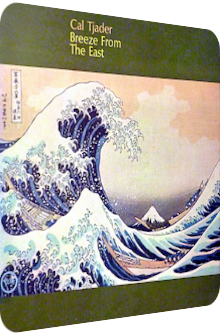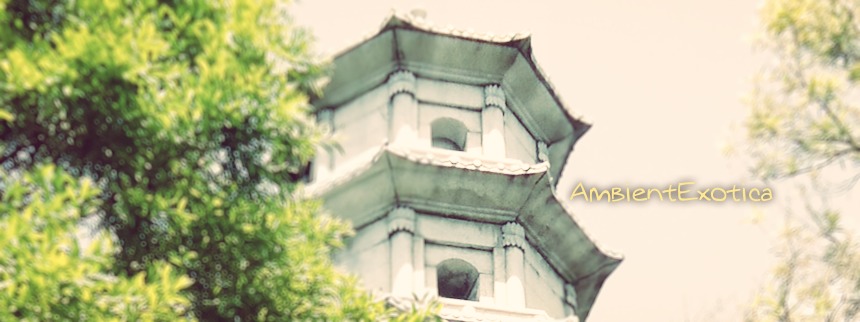
Cal Tjader
Breeze From The East
1964
One of my favorite vibraphonists? Cal Tjader (1925–1982)! One of my favorite tonalities in music? Clichéd Far Eastern sequences! Enter Breeze From The East, one of Tjader's hallmarks recorded in 1963, three days after the assassination of John F. Kennedy. Released in early 1964, it presents a successful fusion of Cool Jazz, Easy Listening… and Exotica. One of Tjader's key strengths has always been the carved-out main melodies which are delicately accentuated by swirling organs, making his music the forerunner of the Lounge genre that survived to this day. Eleven colorful tunes are collected on here, and please note that I'm writing about tunes, not renditions, for the majority of the included material comes directly from the mind of Tjader and his band mates.
Speaking of the band: Cal Tjader leads a septet on this release, which results in a richer sound, vivid interplays, convivial warmth and just the right dose of mystery and tranquility whenever these moods are needed. While Cal Tjader plays the vibes, arranger Stan Applebaum plays the celesta, George Duvivier provides the bass, Johnny Rae performs on the drums, Jerry Dodgion comes up with wonderful flute tones, the legendary Dick Hyman pushes his organs to the max, Lonnie Hewitt is on the piano, and finally, Willie Bobo brings in an arsenal of percussion, both exotic and jazzy. The unique selling point of this album – which at first seems to deliver more of the same Asian craze that is so commonplace in the Exotica genre – is the unique blend of the East with the West.
Tak Shindo tries the same in a lot of his albums, among them Brass And Bamboo (1959) and Far East Goes Western (1962), but only Tjader succeeds in injecting short outbursts of Japanese melodies in otherwise funky compositions. Never does the octet deliver a boldly Eastern track; once the listener seems to be able to pinpoint a specific mood, a new counteracting passage opens. It's this incessant interplay and joyful mood that works so great. In tandem with the easy-to-grasp melodies and the less snobby solo performances, this album is a feast for both Exotica fans, pre-Funk seekers and Jazz novices – you decide what to make of these fuzzy descriptions. Non-fuzzy descriptions follow below, as I talk about each of the eleven songs in greater detail.
Sake And Greens launches the album in a stereotypical fashion. Written by arranger Stan Applebaum, Duvivier's wonky double bass and the shattering smoothness of Bobo's shakers provide a good backing panorama for Tjader's vibes to shine. Oscillating between mystique and majesty – the latter mood nurtured further by Hewitt's droning piano chords –, the famous vibraphonist is always keen on letting the warped sustain mesh with the following note. Balmy celesta waves and an acoustic guitar played in Hawaiian style round off this composition that is nonetheless topped one last time by cinematic, sunset-red staccato piano chords of the liquedous kind which take the phantasmagoric aura to new regions. Sake And Greens is a terrific opener, and if you think that the vibes are on the foreground, for it is after all a septet led by Cal Tjader, you couldn't be farther away from its nucleus. Each and every band member delivers a glowing performance, and the Far Eastern style is skillfully intertwined with a localless grandeur; sine this song is also upbeat, it is perfectly suitable for jogging/running and will make you feel more alive than ever when the climax hits in the right moment, at the right time, in the right surroundings. A big opener!
Up next is Cha, another arrangement by Applebaum, and things are getting funky on there: a three-note motif on the bass guitar which is itself backed by a second repetitive accentuation on another bass guitar is rumbling along to the castanet-laden groove, mellow vibe sequences and an awesome inclusion of Hyman's Hammond organ. It is the surf guitar, however, which provides the Asian flavor on this take, and still, the mood shuttles once again between pure U.S.-centric pre-70's Funk and Eastern stereotypes, making this a positively frantic, joyful contender as well.
Leyte is a laid-back downbeat tune co-written by Tjader with his pianist Lonnie Hewitt. It mixes grove-evoking celesta droplets with gorgeously sun-soaked Balearic guitars, vibraphone scatters, car horn organs and an unexpected accompaniment of several violin strings. I don't know who is playing these, but they are definitely real and not of the synthetic kind. Leyte is significantly dreamy and surprises with an echoey setting of a wideness that was heretofore neglected by the octet. Shoji is a cheeky Applebaum composition with jocular Honky Tonk piano chords, funk guitar twangs and a mélange of glockenspiels, vibraphones, celestas and xylophones as well as organ intersections; this is Exotica par excellence thanks to the mallet instrument overkill and the bright mood that inherits the aura of beachcombing and Surf Sundays. I have to admit that this particular song is a little bit too saccharine, and the stomping piano chords do nothing for me, but that's purely my loss, especially in regard to the mallet instrument thicket which I actually do like.
While China Nights is the first rendition on this album of Nobuyuki Takeoka's and Yaso Saijo's nocturnal Jazz classic on which Cal Tjader and crew stay very close to the original with jazzy double bass backings, deliciously warm piano chords, clinging cymbals, spiraling vibraphone improvisations and one too many beats of a Chinese temple gong, the following last song of side A, Cal Tjader's Fuji, is an utterly brilliant depiction of a nightly panorama full of moon-lit vibraphone droplets, strongly memorable three-note violin accents, a jazzy 6/8 rhythm shift with a rising string crescendo and triangle scintillae. The mood is hard to describe. A certain mystique is definitely perceptible, but a relaxed kind of joy and contentment are much stronger and thus put prominently into the moonlight. One of Tjader's very best original tracks. Fans of that special kind of dark Exotica, where the respective pieces are illuminated by a rose-tinted aura, should check this one out.
Side B starts with my most-favorite Cal Tjader composition of all times. That's it in a nutshell. The iconic Black Orchid has been delivered time and again by him and is an essential inclusion on all of Tjader's Best Of compilations. The dreaminess encapsulates the listener in psychedelia. This version isn't Tjader's best, I'm sorry to say, but it's definitely strong and vibrant. Starting with the well-known five-note base frame on the contrabass, Rae beats the bongos to the point, their hollowness augments the plasticity of the setting. Tjader plays the vibes in the smoothest, spectral way, he doesn't really beat them rather than tip-toeing over them, creating cozy waves of glinting haze. The eight-note main theme on the piano is delivered by Hewitt, and while its easiness is definitely insulting his true skills on this instrument, he swallows his pride with grace and creates a solemn majesty that is carefully expanded by temple gongs. The second phase of the song includes Dodgion's exhilarative flute tones and additional cymbals, but otherwise keeps the dreamy style alive. Black Orchid is an exotic hallmark, one of the compositions I cannot get enough from. I would even grow a third thumb in order to give a more proper appraisal. It's grand, soothing and remains true to the Exotica spirit.
While Theme From "Burke's Law" by Herschel Burke Gilbert is the rare dud that destroys the carefully built Far Eastern mood with its Surf Rock attitude full of jumpy pianos, sneaky acid guitars and organ bursts, the octet's take on Hoagy Carmichael's Stardust doesn't reach the class of Martin Denny's rendition on Forbidden Island (1958), but is different enough to take a stand; Far Eastern guitar licks, Spanish guitar intersections and an almost whisper-quiet organ creek provide the resplendent setting for Tjader's vibraphone melodies to twinkle. Once the piano enters in the second half and a few violins flow in the background, this song becomes a swinging example despite the omission of brass instruments.
The Latin classic Poinciana follows, and its main attraction is the blurred main melody on the vibes and the celesta, both of which are backed by cozy piano tercets. The main melody, curiously enough, sounds strongly Eastern, even though Tjader remains close to the original and plays it to the point. It must be the liminal half-tones in-between the melody that cause this slight shift away from the Occident. Smooth cymbals and maracas as well as paradisiac flute tones complete this exotic rendition. A Latin classic morphs into a Far Eastern piece; successfully, I might add. The final East Of The Sun (And West Of The Moon) by Brooks Bowman finishes the album with exotic bamboo rod percussion, acoustic guitar backings, kitschy violin strings that sound as if they were taken right off a Jackie Gleason record and Far Eastern vibraphone melodies. It's an underwhelming finale, as it is too streamlined in the given context. There are no inventive intersections, let alone a particularly memorable interplay or even vivid improvisations. It's Easy Listening par excellence, and it evokes a Far Eastern feeling, but lacks esprit otherwise.
Breeze From The East is a huge album with a few shortcomings, but these are of minor importance and don't disturb the grand scheme of things. The octet delivers an imaginative take on a formula that was already wearing thin in the middle of the 60's. Far Eastern albums were already a common scheme back then, but Cal Tjader divides the majority of the given material into an Eastern and a Western section. These sections then merge, depart and coalesce incessantly, so that no element is superior and throning above the other. That most of the included material is unique and either specifically written for this album or transformed into a different version is a huge plus in my book. Renditions of various artists are a golden thread of the Exotica genre, but artists who remake their own songs were and still are in the minority. Tjader and crew give a lot of examples in this regard and start with an absolutely strong side A, while side B has lackluster tunes that don't live up to the hype of the given promise in the title.
Still, this is essential Tjader material, the release date being close enough to both the Exotica craze and the first humble steps of Funk, a genre that thrived and prospered in the 70's. Side A is recommended by me as a whole, while side B features the gargantuan Black Orchid in a version where the vibes are as mellow as can be, and two interesting renditions of Stardust and Poinciana, the latter an Exotica classic that has been delivered many times with birdcalls and exotic percussion, but never before in a Far Eastern style that is as wonderful as on Tjader's take. It's a great album for listeners who want to grow accustomed to the world of Jazz, as there are no eclectic sections to be found on here. The melodies are strong and fresh, but never streamlined, and thanks to the high amount of eight people involved in the process of creation, there is always something going on in each composition, so to speak. An essential Tjader album and a splendid choice for fans of Arthur Lyman who don't mind the first signs of Funk. It's still Exotica. Great Far Eastern Exotica.
Exotica Review 106: Cal Tjader – Breeze From The East (1964). Originally published on Aug. 11, 2012 at AmbientExotica.com.
